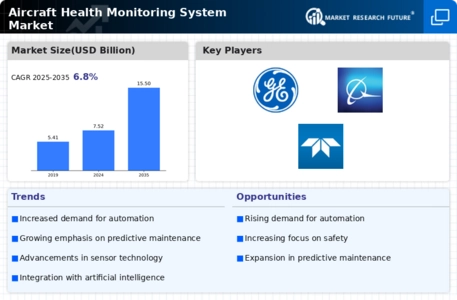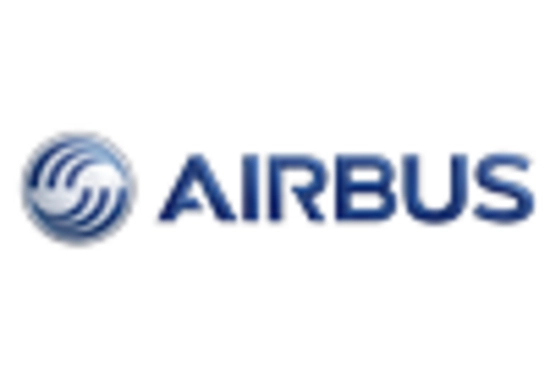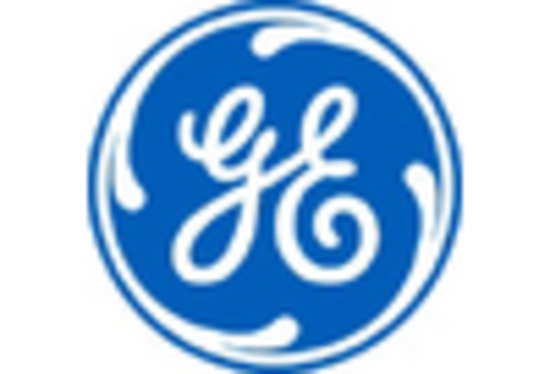-
EXECUTIVE SUMMARY
-
MARKET INTRODUCTION
-
Definition
-
Scope of the Study
- Research Objective
- Assumptions
- Limitations
-
RESEARCH METHODOLOGY
-
Overview
-
Data Mining
-
Secondary Research
-
Primary Research
- Primary Interviews and Information Gathering Process
- Breakdown of Primary Respondents
-
Forecasting Model
-
Market Size Estimation
- Bottom-Up Approach
- Top-Down Approach
-
Data Triangulation
-
Validation
-
MARKET DYNAMICS
-
Overview
-
Drivers
-
Restraints
-
Opportunities
-
MARKET FACTOR ANALYSIS
-
Value Chain Analysis
-
Porter’s Five Forces Analysis
- Bargaining Power of Suppliers
- Bargaining Power of Buyers
- Threat of New Entrants
- Threat of Substitutes
- Intensity of Rivalry
-
COVID-19 Impact Analysis
- Market Impact Analysis
- Regional Impact
- Opportunity and Threat Analysis
-
GLOBAL AIRCRAFT HEALTH MONITORING SYSTEM MARKET, BY TYPE
-
Overview
-
Commercial Aviation
-
Military Aviation
-
GLOBAL AIRCRAFT HEALTH MONITORING SYSTEM MARKET, BY SOLUTION
-
Overview
-
Hardware
-
Software
-
Services
-
GLOBAL AIRCRAFT HEALTH MONITORING SYSTEM MARKET, BY END USER
-
Overview
-
OEMs
-
MRO
-
Aircraft Type
-
GLOBAL AIRCRAFT HEALTH MONITORING SYSTEM MARKET, BY AIRCRAFT TYPE
-
Overview
-
Fixed Wing Aircraft
-
Helicopter
-
GLOBAL AIRCRAFT HEALTH MONITORING SYSTEM MARKET, BY REGION
-
Overview
-
North America
- US
- Canada
-
Europe
- Germany
- France
- UK
- Italy
- Spain
- Rest of Europe
-
Asia-Pacific
- China
- India
- Japan
- South Korea
- Australia
- Rest of Asia-Pacific
-
Rest of the World
- Middle East
- Africa
- Latin America
-
COMPETITIVE LANDSCAPE
-
Overview
-
Competitive Analysis
-
Market Share Analysis
-
Major Growth Strategy in the Global Aircraft Health Monitoring System Market,
-
Competitive Benchmarking
-
Leading Players in Terms of Number of Developments in the Global Aircraft Health Monitoring System Market,
-
Key developments and Growth Strategies
- New Product Launch/Service Deployment
- Merger & Acquisitions
- Joint Ventures
-
Major Players Financial Matrix
- Sales & Operating Income, 2024
- Major Players R&D Expenditure. 2024
-
COMPANY PROFILES
-
Flyht Aerospace Solutions Ltd.
- Company Overview
- Financial Overview
- Products Offered
- Key Developments
- SWOT Analysis
- Key Strategies
-
General Electric
- Company Overview
- Financial Overview
- Products Offered
- Key Developments
- SWOT Analysis
- Key Strategies
-
RSL Electronics Ltd
- Company Overview
- Financial Overview
- Products Offered
- Key Developments
- SWOT Analysis
- Key Strategies
-
Meggitt PLC
- Company Overview
- Financial Overview
- Products Offered
- Key Developments
- SWOT Analysis
- Key Strategies
-
Raytheon Technologies Corporation
- Company Overview
- Financial Overview
- Products Offered
- Key Developments
- SWOT Analysis
- Key Strategies
-
The Boeing Company
- Company Overview
- Financial Overview
- Products Offered
- Key Developments
- SWOT Analysis
- Key Strategies
-
Honeywell International Inc.
- Company Overview
- Financial Overview
- Products Offered
- Key Developments
- SWOT Analysis
- Key Strategies
-
Teledyne Controls LLC
- Company Overview
- Financial Overview
- Products Offered
- Key Developments
- SWOT Analysis
- Key Strategies
-
Rolls-Royce PLC
- Company Overview
- Financial Overview
- Products Offered
- Key Developments
- SWOT Analysis
- Key Strategies
-
Airbus
- Company Overview
- Financial Overview
- Products Offered
- Key Developments
- SWOT Analysis
- Key Strategies
-
APPENDIX
-
References
-
Related Reports
-
-
LIST OF TABLES
-
GLOBAL AIRCRAFT HEALTH MONITORING SYSTEM MARKET, SYNOPSIS, 2018-2032
-
GLOBAL AIRCRAFT HEALTH MONITORING SYSTEM MARKET, ESTIMATES & FORECAST, 2025-2034(USD BILLION)
-
GLOBAL AIRCRAFT HEALTH MONITORING SYSTEM MARKET, BY TYPE, 2025-2034(USD BILLION)
-
GLOBAL AIRCRAFT HEALTH MONITORING SYSTEM MARKET, BY SOLUTION, 2025-2034(USD BILLION)
-
GLOBAL AIRCRAFT HEALTH MONITORING SYSTEM MARKET, BY END USER, 2025-2034(USD BILLION)
-
GLOBAL AIRCRAFT HEALTH MONITORING SYSTEM MARKET, BY AIRCRAFT TYPE, 2025-2034(USD BILLION)
-
NORTH AMERICA: AIRCRAFT HEALTH MONITORING SYSTEM MARKET, BY TYPE, 2025-2034(USD BILLION)
-
NORTH AMERICA: AIRCRAFT HEALTH MONITORING SYSTEM MARKET, BY SOLUTION, 2025-2034(USD BILLION)
-
NORTH AMERICA: AIRCRAFT HEALTH MONITORING SYSTEM MARKET, BY END USER, 2025-2034(USD BILLION)
-
NORTH AMERICA: AIRCRAFT HEALTH MONITORING SYSTEM MARKET, BY AIRCRAFT TYPE, 2025-2034(USD BILLION)
-
US: AIRCRAFT HEALTH MONITORING SYSTEM MARKET, BY TYPE, 2025-2034(USD BILLION)
-
US: AIRCRAFT HEALTH MONITORING SYSTEM MARKET, BY SOLUTION, 2025-2034(USD BILLION)
-
US: AIRCRAFT HEALTH MONITORING SYSTEM MARKET, BY END USER, 2025-2034(USD BILLION)
-
US: AIRCRAFT HEALTH MONITORING SYSTEM MARKET, BY AIRCRAFT TYPE, 2025-2034(USD BILLION)
-
CANADA: AIRCRAFT HEALTH MONITORING SYSTEM MARKET, BY TYPE, 2025-2034(USD BILLION)
-
CANADA: AIRCRAFT HEALTH MONITORING SYSTEM MARKET, BY SOLUTION, 2025-2034(USD BILLION)
-
CANADA: AIRCRAFT HEALTH MONITORING SYSTEM MARKET, BY END USER, 2025-2034(USD BILLION)
-
CANADA: AIRCRAFT HEALTH MONITORING SYSTEM MARKET, BY AIRCRAFT TYPE, 2025-2034(USD BILLION)
-
EUROPE: AIRCRAFT HEALTH MONITORING SYSTEM MARKET, BY TYPE, 2025-2034(USD BILLION)
-
EUROPE: AIRCRAFT HEALTH MONITORING SYSTEM MARKET, BY SOLUTION, 2025-2034(USD BILLION)
-
EUROPE: AIRCRAFT HEALTH MONITORING SYSTEM MARKET, BY END USER, 2025-2034(USD BILLION)
-
EUROPE: AIRCRAFT HEALTH MONITORING SYSTEM MARKET, BY AIRCRAFT TYPE, 2025-2034(USD BILLION)
-
GERMANY: AIRCRAFT HEALTH MONITORING SYSTEM MARKET, BY TYPE, 2025-2034(USD BILLION)
-
GERMANY: AIRCRAFT HEALTH MONITORING SYSTEM MARKET, BY SOLUTION, 2025-2034(USD BILLION)
-
GERMANY: AIRCRAFT HEALTH MONITORING SYSTEM MARKET, BY END USER, 2025-2034(USD BILLION)
-
GERMANY: AIRCRAFT HEALTH MONITORING SYSTEM MARKET, BY AIRCRAFT TYPE, 2025-2034(USD BILLION)
-
FRANCE: AIRCRAFT HEALTH MONITORING SYSTEM MARKET, BY TYPE, 2025-2034(USD BILLION)
-
FRANCE: AIRCRAFT HEALTH MONITORING SYSTEM MARKET, BY SOLUTION, 2025-2034(USD BILLION)
-
FRANCE: AIRCRAFT HEALTH MONITORING SYSTEM MARKET, BY END USER, 2025-2034(USD BILLION)
-
FRANCE: AIRCRAFT HEALTH MONITORING SYSTEM MARKET, BY AIRCRAFT TYPE, 2025-2034(USD BILLION)
-
ITALY: AIRCRAFT HEALTH MONITORING SYSTEM MARKET, BY TYPE, 2025-2034(USD BILLION)
-
ITALY: AIRCRAFT HEALTH MONITORING SYSTEM MARKET, BY SOLUTION, 2025-2034(USD BILLION)
-
ITALY: AIRCRAFT HEALTH MONITORING SYSTEM MARKET, BY END USER, 2025-2034(USD BILLION)
-
ITALY: AIRCRAFT HEALTH MONITORING SYSTEM MARKET, BY AIRCRAFT TYPE, 2025-2034(USD BILLION)
-
SPAIN: AIRCRAFT HEALTH MONITORING SYSTEM MARKET, BY TYPE, 2025-2034(USD BILLION)
-
SPAIN: AIRCRAFT HEALTH MONITORING SYSTEM MARKET, BY SOLUTION, 2025-2034(USD BILLION)
-
SPAIN: AIRCRAFT HEALTH MONITORING SYSTEM MARKET, BY END USER, 2025-2034(USD BILLION)
-
SPAIN: AIRCRAFT HEALTH MONITORING SYSTEM MARKET, BY AIRCRAFT TYPE, 2025-2034(USD BILLION)
-
UK: AIRCRAFT HEALTH MONITORING SYSTEM MARKET, BY TYPE, 2025-2034(USD BILLION)
-
UK: AIRCRAFT HEALTH MONITORING SYSTEM MARKET, BY SOLUTION, 2025-2034(USD BILLION)
-
UK: AIRCRAFT HEALTH MONITORING SYSTEM MARKET, BY END USER, 2025-2034(USD BILLION)
-
UK: AIRCRAFT HEALTH MONITORING SYSTEM MARKET, BY AIRCRAFT TYPE, 2025-2034(USD BILLION)
-
REST OF EUROPE: AIRCRAFT HEALTH MONITORING SYSTEM MARKET, BY TYPE, 2025-2034(USD BILLION)
-
REST OF EUROPE: AIRCRAFT HEALTH MONITORING SYSTEM MARKET, BY SOLUTION, 2025-2034(USD BILLION)
-
REST OF EUROPE: AIRCRAFT HEALTH MONITORING SYSTEM MARKET, BY END USER, 2025-2034(USD BILLION)
-
REST OF EUROPE: AIRCRAFT HEALTH MONITORING SYSTEM MARKET, BY AIRCRAFT TYPE, 2025-2034(USD BILLION)
-
ASIA-PACIFIC: AIRCRAFT HEALTH MONITORING SYSTEM MARKET, BY TYPE, 2025-2034(USD BILLION)
-
ASIA-PACIFIC: AIRCRAFT HEALTH MONITORING SYSTEM MARKET, BY SOLUTION, 2025-2034(USD BILLION)
-
ASIA-PACIFIC: AIRCRAFT HEALTH MONITORING SYSTEM MARKET, BY END USER, 2025-2034(USD BILLION)
-
ASIA-PACIFIC: AIRCRAFT HEALTH MONITORING SYSTEM MARKET, BY AIRCRAFT TYPE, 2025-2034(USD BILLION)
-
JAPAN: AIRCRAFT HEALTH MONITORING SYSTEM MARKET, BY TYPE, 2025-2034(USD BILLION)
-
JAPAN: AIRCRAFT HEALTH MONITORING SYSTEM MARKET, BY SOLUTION, 2025-2034(USD BILLION)
-
JAPAN: AIRCRAFT HEALTH MONITORING SYSTEM MARKET, BY END USER, 2025-2034(USD BILLION)
-
JAPAN: AIRCRAFT HEALTH MONITORING SYSTEM MARKET, BY AIRCRAFT TYPE, 2025-2034(USD BILLION)
-
CHINA: AIRCRAFT HEALTH MONITORING SYSTEM MARKET, BY TYPE, 2025-2034(USD BILLION)
-
CHINA: AIRCRAFT HEALTH MONITORING SYSTEM MARKET, BY SOLUTION, 2025-2034(USD BILLION)
-
CHINA: AIRCRAFT HEALTH MONITORING SYSTEM MARKET, BY END USER, 2025-2034(USD BILLION)
-
CHINA: AIRCRAFT HEALTH MONITORING SYSTEM MARKET, BY AIRCRAFT TYPE, 2025-2034(USD BILLION)
-
INDIA: AIRCRAFT HEALTH MONITORING SYSTEM MARKET, BY TYPE, 2025-2034(USD BILLION)
-
INDIA: AIRCRAFT HEALTH MONITORING SYSTEM MARKET, BY SOLUTION, 2025-2034(USD BILLION)
-
INDIA: AIRCRAFT HEALTH MONITORING SYSTEM MARKET, BY END USER, 2025-2034(USD BILLION)
-
INDIA: AIRCRAFT HEALTH MONITORING SYSTEM MARKET, BY AIRCRAFT TYPE, 2025-2034(USD BILLION)
-
AUSTRALIA: AIRCRAFT HEALTH MONITORING SYSTEM MARKET, BY TYPE, 2025-2034(USD BILLION)
-
AUSTRALIA: AIRCRAFT HEALTH MONITORING SYSTEM MARKET, BY SOLUTION, 2025-2034(USD BILLION)
-
AUSTRALIA: AIRCRAFT HEALTH MONITORING SYSTEM MARKET, BY END USER, 2025-2034(USD BILLION)
-
AUSTRALIA: AIRCRAFT HEALTH MONITORING SYSTEM MARKET, BY AIRCRAFT TYPE, 2025-2034(USD BILLION)
-
SOUTH KOREA: AIRCRAFT HEALTH MONITORING SYSTEM MARKET, BY TYPE, 2025-2034(USD BILLION)
-
SOUTH KOREA: AIRCRAFT HEALTH MONITORING SYSTEM MARKET, BY SOLUTION, 2025-2034(USD BILLION)
-
SOUTH KOREA: AIRCRAFT HEALTH MONITORING SYSTEM MARKET, BY END USER, 2025-2034(USD BILLION)
-
SOUTH KOREA: AIRCRAFT HEALTH MONITORING SYSTEM MARKET, BY AIRCRAFT TYPE, 2025-2034(USD BILLION)
-
REST OF ASIA-PACIFIC: AIRCRAFT HEALTH MONITORING SYSTEM MARKET, BY TYPE, 2025-2034(USD BILLION)
-
REST OF ASIA-PACIFIC: AIRCRAFT HEALTH MONITORING SYSTEM MARKET, BY SOLUTION, 2025-2034(USD BILLION)
-
REST OF ASIA-PACIFIC: AIRCRAFT HEALTH MONITORING SYSTEM MARKET, BY END USER, 2025-2034(USD BILLION)
-
REST OF ASIA-PACIFIC: AIRCRAFT HEALTH MONITORING SYSTEM MARKET, BY AIRCRAFT TYPE, 2025-2034(USD BILLION)
-
REST OF THE WORLD: AIRCRAFT HEALTH MONITORING SYSTEM MARKET, BY TYPE, 2025-2034(USD BILLION)
-
REST OF THE WORLD: AIRCRAFT HEALTH MONITORING SYSTEM MARKET, BY SOLUTION, 2025-2034(USD BILLION)
-
REST OF THE WORLD: AIRCRAFT HEALTH MONITORING SYSTEM MARKET, BY END USER, 2025-2034(USD BILLION)
-
REST OF THE WORLD: AIRCRAFT HEALTH MONITORING SYSTEM MARKET, BY AIRCRAFT TYPE, 2025-2034(USD BILLION)
-
MIDDLE EAST: AIRCRAFT HEALTH MONITORING SYSTEM MARKET, BY TYPE, 2025-2034(USD BILLION)
-
MIDDLE EAST: AIRCRAFT HEALTH MONITORING SYSTEM MARKET, BY SOLUTION, 2025-2034(USD BILLION)
-
MIDDLE EAST: AIRCRAFT HEALTH MONITORING SYSTEM MARKET, BY END USER, 2025-2034(USD BILLION)
-
MIDDLE EAST: AIRCRAFT HEALTH MONITORING SYSTEM MARKET, BY AIRCRAFT TYPE, 2025-2034(USD BILLION)
-
AFRICA: AIRCRAFT HEALTH MONITORING SYSTEM MARKET, BY TYPE, 2025-2034(USD BILLION)
-
AFRICA: AIRCRAFT HEALTH MONITORING SYSTEM MARKET, BY SOLUTION, 2025-2034(USD BILLION)
-
AFRICA: AIRCRAFT HEALTH MONITORING SYSTEM MARKET, BY END USER, 2025-2034(USD BILLION)
-
AFRICA: AIRCRAFT HEALTH MONITORING SYSTEM MARKET, BY AIRCRAFT TYPE, 2025-2034(USD BILLION)
-
LATIN AMERICA: AIRCRAFT HEALTH MONITORING SYSTEM MARKET, BY TYPE, 2025-2034(USD BILLION)
-
LATIN AMERICA: AIRCRAFT HEALTH MONITORING SYSTEM MARKET, BY SOLUTION, 2025-2034(USD BILLION)
-
LATIN AMERICA: AIRCRAFT HEALTH MONITORING SYSTEM MARKET, BY END USER, 2025-2034(USD BILLION)
-
LATIN AMERICA: AIRCRAFT HEALTH MONITORING SYSTEM MARKET, BY AIRCRAFT TYPE, 2025-2034(USD BILLION)
-
LIST OF FIGURES
-
RESEARCH PROCESS
-
MARKET STRUCTURE FOR THE GLOBAL AIRCRAFT HEALTH MONITORING SYSTEM MARKET
-
MARKET DYNAMICS FOR THE GLOBAL AIRCRAFT HEALTH MONITORING SYSTEM MARKET
-
GLOBAL AIRCRAFT HEALTH MONITORING SYSTEM MARKET, SHARE (%), BY TYPE, 2024
-
GLOBAL AIRCRAFT HEALTH MONITORING SYSTEM MARKET, SHARE (%), BY SOLUTION, 2024
-
GLOBAL AIRCRAFT HEALTH MONITORING SYSTEM MARKET, SHARE (%), BY END USER, 2024
-
GLOBAL AIRCRAFT HEALTH MONITORING SYSTEM MARKET, SHARE (%), BY AIRCRAFT TYPE, 2024
-
GLOBAL AIRCRAFT HEALTH MONITORING SYSTEM MARKET, SHARE (%), BY REGION, 2024
-
NORTH AMERICA: AIRCRAFT HEALTH MONITORING SYSTEM MARKET, SHARE (%), BY REGION, 2024
-
EUROPE: AIRCRAFT HEALTH MONITORING SYSTEM MARKET, SHARE (%), BY REGION, 2024
-
ASIA-PACIFIC: AIRCRAFT HEALTH MONITORING SYSTEM MARKET, SHARE (%), BY REGION, 2024
-
REST OF THE WORLD: AIRCRAFT HEALTH MONITORING SYSTEM MARKET, SHARE (%), BY REGION, 2024
-
GLOBAL AIRCRAFT HEALTH MONITORING SYSTEM MARKET: COMPANY SHARE ANALYSIS, 2024 (%)
-
FLYHT AEROSPACE SOLUTIONS LTD.: FINANCIAL OVERVIEW SNAPSHOT
-
FLYHT AEROSPACE SOLUTIONS LTD.: SWOT ANALYSIS
-
GENERAL ELECTRIC: FINANCIAL OVERVIEW SNAPSHOT
-
GENERAL ELECTRIC: SWOT ANALYSIS
-
RSL ELECTRONICS LTD: FINANCIAL OVERVIEW SNAPSHOT
-
RSL ELECTRONICS LTD: SWOT ANALYSIS
-
MEGGITT PLC: FINANCIAL OVERVIEW SNAPSHOT
-
MEGGITT PLC: SWOT ANALYSIS
-
RAYTHEON TECHNOLOGIES CORPORATION: FINANCIAL OVERVIEW SNAPSHOT
-
RAYTHEON TECHNOLOGIES CORPORATION: SWOT ANALYSIS
-
THE BOEING COMPANY: FINANCIAL OVERVIEW SNAPSHOT
-
THE BOEING COMPANY: SWOT ANALYSIS
-
HONEYWELL INTERNATIONAL INC.: FINANCIAL OVERVIEW SNAPSHOT
-
HONEYWELL INTERNATIONAL INC.: SWOT ANALYSIS
-
TELEDYNE CONTROLS LLC: FINANCIAL OVERVIEW SNAPSHOT
-
TELEDYNE CONTROLS LLC: SWOT ANALYSIS
-
ROLLS-ROYCE PLC: FINANCIAL OVERVIEW SNAPSHOT
-
ROLLS-ROYCE PLC: SWOT ANALYSIS
-
AIRBUS: FINANCIAL OVERVIEW SNAPSHOT
-
AIRBUS: SWOT ANALYSIS









Leave a Comment